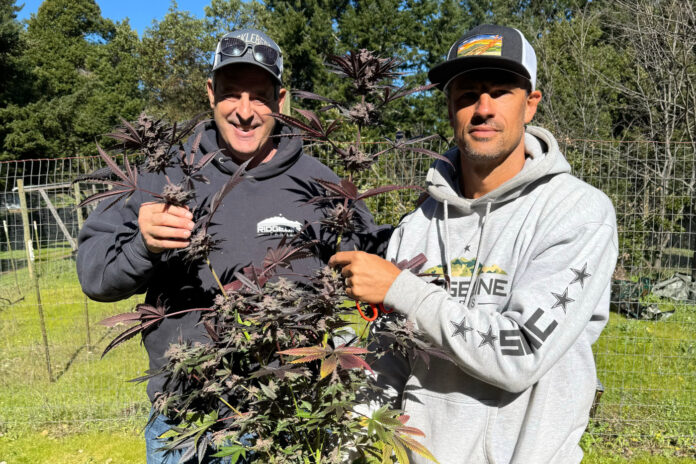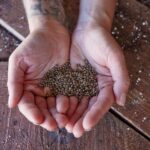The cannabis marketplace is becoming increasingly crowded. In the absence of many traditional marketing channels, brands must think outside the box to appeal to their target audiences and win customer loyalty.
Proprietary, in-house cannabis genetics are one such strategy. It’s a high-risk, high-reward undertaking — pheno hunting, betting big on a plant with potential by bringing it to production, and marketing the new strain to the masses all take time and money — but a new strain catching fire can change a brand’s trajectory forever.
“I didn’t realize how important it was at first to have my own strains on the market but quickly saw it was a game changer,” said Jason Gellman, owner of Ridgeline Farms and creator of the award-winning Lantz strain. “You could compete with every other brand growing the same strains, or you could set yourself apart growing your own unique strains. That is exactly what I did and continue to do.”
Varieties like GSC (formerly Girl Scout Cookies), Blueberry Muffin, and Whitethorn Rose are synonymous with cannabis culture and, consequently, so are the brands behind them that loaded the bases, took a big swing, and hit a grand slam.
“Real quality strains will rise above and persevere if given wide enough accessibility,” said Ted Lidie, founder and chief executive officer at Alien Labs. “The overall quality is so good and the effects are so appealing that, over time, word of mouth will elevate a strain into the mainstream. Strains like Sour Diesel, OG Kush, Biscotti, and Grand Daddy Purple have become legendary not merely through marketing but because their quality has earned them permanent status—cementing their legacy in the culture. Through the years, they have been immortalized as some of the greatest strains of all time.”
Creating real, not hype
But in a market driven by the hype engine, how do companies create the next big thing in weed and ensure their brainchild goes the distance? Some brands accomplish the feat by accident, but most employ a strategy.
Consumers may have their all-time favorites, but when something innovative hits the scene the buzz can be explosive. For many brands, that means being first to market.
Cookies, arguably one of the most recognizable brands in the world, has created several game-changing genetics over the years that continue to appeal to consumers. From GSC to Cereal Milk, the hits just keep on coming. When it comes to introducing new varieties to the market, the team strives to be ahead of the curve.
“We look for breeding gaps in the market in terms of flavor and uniqueness and create cultivars to fill those gaps and meet that consumer demand,” said London Van Der Kamp, director of product development and innovation. “We put our Cookies micro-batch research-and-development program into the market for our consumers to be able to tell us straight up what they want to buy. Then we analyze those buying trends and make decisions on what products to make more permanent in our lineup.”
Creating something new and exciting is front of mind for breeders and brands. Sensing something unusual in all the right ways during their development process is a sign of a possible slam dunk. Such was the case with Pink Jesus, a particularly unique and popular cultivar from Sonoma Hills Farm.
“Our co-founder Sam Magruder knew immediately that the look, scent, and high of his new strain was unique,” said Chief Operating Officer Joyce Cenali. “While many breeders are working hard to create strains that smell just like lemons or cherries, Pink Jesus is harder to categorize and more open to interpretation. Her terpene profile and bouquet are myrcene- and lavender-dominant, but each smell adds more nuance and new notes and complexity.”
Pheno-hunting for cannabis genetics
There’s no doubt producing an entirely new strain takes a decent amount of work. Many brands, whether due to licensing issues or lack of resources, simply white-label a product and call it their own. But those who wish to make the biggest impact create something themselves. Doing so starts with breeding.
Typically, companies start by identifying genetics that already have desired traits. Breeders take female plants of one such strain and hand-pollinate using pollen from male plants of another, generating seeds. Those seeds then are planted during something called a pheno hunt. Of the plants that grow from the seed batch, usually only a few are selected for production.
Humboldt Seed Company (HSC), a large-scale producer of cannabis genetics, encourages brands to take pheno hunting seriously. The Northern California breeder is known for its massive hunts spanning multiple farms, allowing the team to see how strains perform in different growing conditions using proprietary metrics.
“Every year, we do a large-scale pheno hunt where we evaluate ten new crosses at 1,000 plants each,” HSC founder and Chief Executive Officer Nathaniel Pennington said. “We have a phenotype rating sheet available on our website that can be downloaded and used to score observable traits in the field. A respectable number to assess to get an idea of the potential of a seed batch would be around thirty individual plants.”
So what makes a contender a first-place finisher in a pheno hunt? When the Cookies team is developing new strains, a potential pick must tick a bunch of boxes. “Our cultivars must meet all the most important factors: appearance, aroma, flavor, and experience. We call this full-package herb,” said Van Der Kamp.
John Casali, owner of Huckleberry Hill Farms and creator of the white-hot strain Whitethorn Rose, leads with his nose in the pheno-hunting process. “I don’t know if we’re looking for anything in particular,” he said. “But when you smell it, you know that’s the one.”
Casali also said plants that make the cut must produce high yields without any signs of powdery mildew.
Marketing magic
Once a brand has determined it may have a potential hit on its hands, it’s time to let the world know. It’s one thing to create a cool label and educate retail staff about the product, but going the extra mile is necessary to make a real splash. For example, the Cookies apparel line transcends subcultures, gaining fans even where cannabis remains illegal. Other brands opt to partner with mainstream companies to widen appeal. These moves create demand outside the industry and help brands gain fans in more than one way, ultimately leading to increased visibility.
Sonoma Hills Farm has had multiple mainstream Pink Jesus collabs, from a non-infused sorbet with San Francisco Bay Area ice cream icon Humphry Slocombe to an upcoming perfume line. Cenali said the projects are just another example of how the strain has made its mark.
“Pink Jesus is really more of an experience than a strain. Her unique look, scent, and high has really inspired some amazing artists and craftspeople who have come to the farm,” Cenali said. “From famed Master Sommelier Ian Cauble to Master Perfumer Johan Bergellin, Pink Jesus has captured the imagination of many people both inside and outside the cannabis community.”
The emerging canna-tourism sector is another way for brands to showcase their signature cannabis genetics. For Casali, the decision to offer farm tours led to some of the best organic marketing he’s ever experienced. A guest at Huckleberry Hill happened to be connected to comedian Bert “The Machine” Kreischer, who shared some of Casali’s sungrown Whitethorn Rose with the famed podcast host. Kreischer was impressed enough to tout the bud on multiple podcasts, at one point calling it “the perfect weed.”
“More than 500 people reached out to me after the first mention. Then, he did it again,” Casali said, adding the impromptu endorsement brought an awareness to Whitethorn Rose that he could not have achieved on his own.
The shoutouts introduced Huckleberry Hill Farms and other Emerald Triangle growers, including Gellman’s Ridgeline Farms, to an even wider audience. The cultivators were invited to be guests on Kreischer’s Something’s Burning podcast and hope to work with the comedian and others like him on future projects.
“It’s gone farther out into the world than I could have ever hoped for or imagined,” Casali said of Whitethorn Rose. “It’s a reminder of how important it is for craft, sungrown farmers to really highlight their stories and some of their legacy strains. The consumer has been able to attach themselves to strains not only for the taste, flavor, and effect but also for our story. They become part of our family.”
Tips and tricks
Some brands license their cannabis genetics or make them available for other commercial and home cultivators in an attempt to increase awareness. But Casali cautions that approach can represent a double-edged sword, since a strain associated with your brand could become a far different and possibly subpar product under a different producer. He prefers to collaborate with hashmakers and other manufacturers who incorporate his plant material into their products.
When asked about tips and tricks for operators who want to develop proprietary cannabis genetics, breeders agreed stakeholders should be involved early and often. In addition, prospective breeders should work to develop consensus about the strain characteristics that match their brand.
“If brands want to craft in-house strains that embody their brand story and ethos, they need to have a heavy hand in every step of the process and not skimp out on the [research and development],” Cookies’ Van Der Camp said.
Much like Cookies does with its micro-batches, Casali urged brands to let their audiences be the real judges. “Find your own strain, market and brand it as best you can, and then listen to the consumer,” he said.













[…] rely on humans who may skew, forget to record, or fail to hand over data upon leaving the company. Tracking crop progress allows companies to be confident in the data obtained and retain it for access years later. In […]
[…] training teams to maximize the genetic potential of their plants with the best nutrients and training for each cultivar on its journey to a triumphant […]